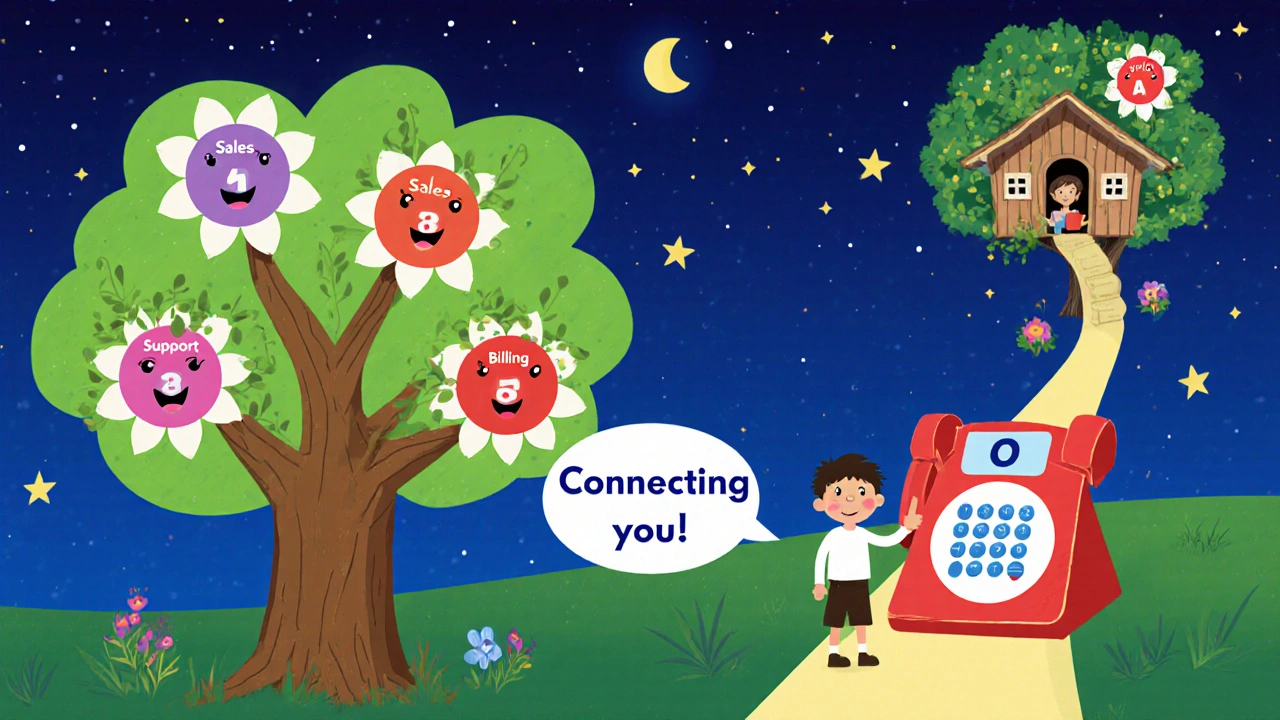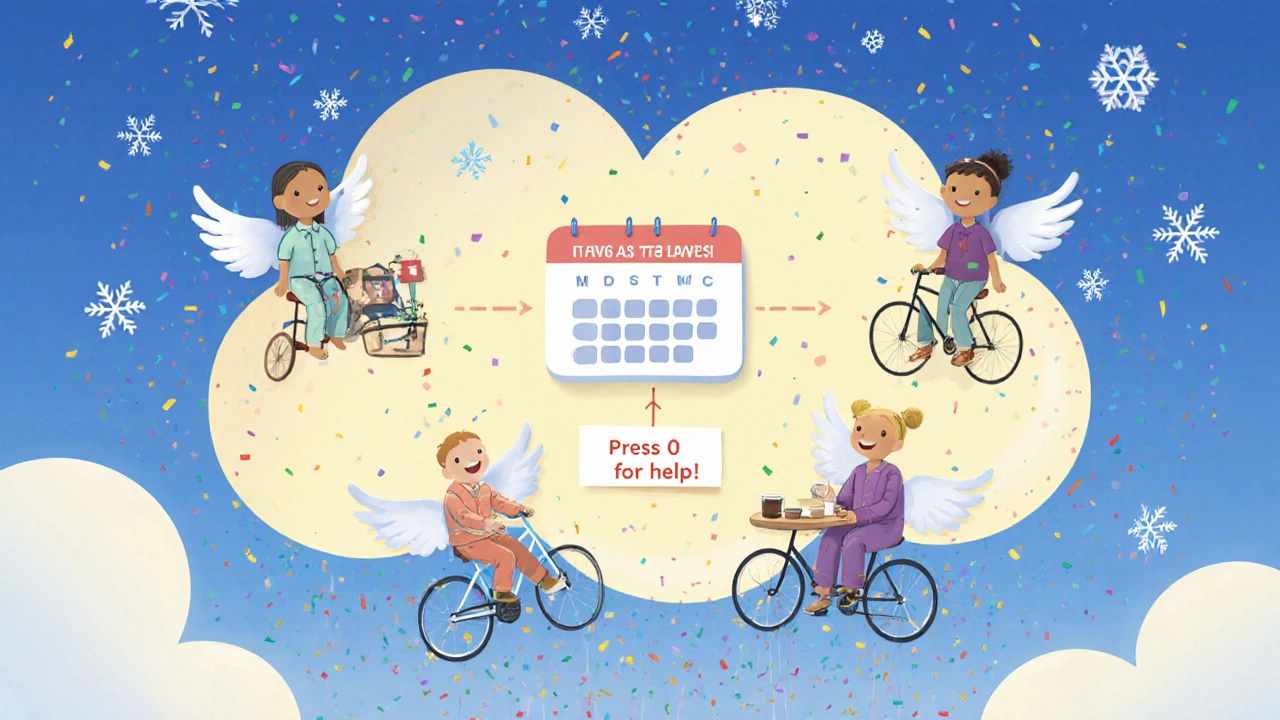When your team works from different cities, time zones, or even countries, a missed call isn’t just inconvenient-it’s a lost customer. That’s why remote teams are switching to virtual receptionists-automated phone systems that answer calls, route them correctly, and never sleep. Unlike old-school phone systems that required physical hardware and on-site staff, today’s auto-attendants run in the cloud and work just as well for someone in Berlin as they do for someone in Boise.
Why Your Remote Team Needs an Auto-Attendant
Imagine this: It’s 8:45 PM in New York, and a potential client calls your business line. No one’s in the office. The call goes to voicemail. The client leaves a message, but never calls back. That’s what happens without an auto-attendant.
With a properly set up virtual receptionist, that same call gets answered by a professional greeting: “Thank you for calling TechFlow Solutions. For sales, press 1. For support, press 2. To reach a live person after hours, press 0.” The caller gets options. They feel heard. And if they press 0, the call routes to the on-call team member’s phone-no matter where they are.
According to a 2022 Dialzara survey of 1,245 small and midsize businesses, 78% saw improved customer satisfaction after installing a virtual receptionist. Why? Because callers don’t feel ignored. They get a clear path forward-even when your team is offline.
How Auto-Attendants Work (Without the Jargon)
An auto-attendant is basically a phone tree powered by Interactive Voice Response (IVR). When someone calls, they hear a recorded message with numbered options. They press a number on their keypad-or speak a command-and the system sends the call to the right person or department.
Modern systems go beyond simple key presses. Platforms like Google Voice and Microsoft Teams now use speech recognition so callers can say, “I need billing help,” instead of pressing buttons. The system listens, understands, and routes the call-no menu required.
These systems don’t run on your office phone line. They live in the cloud. That means:
- You don’t need physical phones or wiring
- Call routing works whether your team is at home, in a café, or overseas
- You can set different rules for business hours, weekends, and holidays
- Voicemails turn into emails automatically
Latency is under 300 milliseconds-fast enough that callers don’t notice delays. Most platforms support 10+ concurrent calls per auto-attendant and guarantee 99.99% uptime.
Choosing the Right Platform for Your Team
Not all virtual receptionist systems are built the same. Here’s how the top platforms stack up for remote teams in 2025:
| Platform | Price (per user/month) | Menu Levels | Speech Recognition | Time Zone Support | Best For |
|---|---|---|---|---|---|
| Microsoft Teams | $12+ | 10 nested levels | Yes (AI-powered in 2024) | 142 regions | Teams users, calendar-based routing |
| Google Voice | $12+ | 3 levels | 92% accuracy | Global with manual setup | Simple setups, speech accuracy |
| Zoom Phone | $10+ | 5 levels | 87% accuracy | 140+ regions | Video-first teams, high uptime |
| Phone.com | $12.99 flat | Unlimited | Yes | Custom schedules | Small teams, no per-user fees |
| RingCentral | $19.99+ | 5 levels | Yes | 62 languages | Global teams, multilingual support |
Microsoft Teams wins if your team already uses Outlook and Teams meetings. The system can automatically route calls based on who’s available in their calendar. Google Voice is best if you care most about accurate voice recognition. Zoom is solid for reliability. Phone.com is the cheapest for teams under 10 people. RingCentral leads if you have international callers who speak different languages.

7 Steps to Set Up Your Auto-Attendant (No Tech Degree Needed)
Setting up your virtual receptionist doesn’t require an IT team. Here’s how to do it in under an hour:
- Pick a phone number. Most teams choose a toll-free number (like 800-XXX-XXXX) to look more professional and national. 68% of remote businesses do this, according to Dialzara’s 2022 survey.
- Create your schedule. Map out your business hours, holidays, and weekend rules. If you have team members in different time zones, make sure the system adjusts automatically. Microsoft Teams does this by syncing with Outlook calendars. Google Voice requires manual setup.
- Record your greeting. Keep it under 15 seconds. Google’s research shows that when greetings go past 15 seconds, caller abandonment jumps from 8% to 27%. Use a clear, calm voice. Avoid music or background noise.
- Design your menu. Stick to 3-5 options on the main menu. Experts like John Shepler say more than that causes callers to hang up. Example: “Press 1 for sales, 2 for support, 3 for billing, 0 to speak to someone.”
- Set up call routing. Link each menu option to a person, department, or voicemail. 73% of remote teams forward calls to mobile phones-so make sure your team’s cell numbers are in the system.
- Configure overflow. Always include a “0” option to reach a live person. This reduces hang-ups by 19%, according to Emitrr’s 2022 data. You can route overflow to a team member on call or a voicemail.
- Test it. Call your own number. Go through every option. Check if voicemails arrive as emails. Test it from a mobile phone and a landline. Google’s advice? “Call your number like you’re a customer.”
Common Mistakes (And How to Avoid Them)
Even simple setups can go wrong. Here are the top 3 errors remote teams make-and how to fix them:
- Too many menu levels. Gartner found that callers get 31% more frustrated when menus go beyond 3 levels. If you need more options, use sub-menus-but only after the first choice. Example: After pressing “2 for support,” then “1 for technical help,” “2 for account help.”
- Wrong time zone settings. 41% of remote teams report scheduling errors. If your team is in California but your business is registered in New York, make sure the system uses the right local time. Test this by setting a temporary after-hours rule and calling during that time.
- Bad audio quality. If your greeting sounds echoey or muffled, callers won’t trust your brand. Record in a quiet room with a decent mic. Use free tools like Audacity to clean up background noise. Google’s UX team found that natural-sounding greetings reduce call handling time by 22 seconds.

What’s Next? AI Is Changing the Game
Auto-attendants aren’t just answering calls anymore-they’re starting to understand them.
Microsoft is rolling out AI-powered natural language understanding in Teams by Q2 2024. That means callers won’t need to press buttons at all. They can say, “I need to reschedule my appointment,” and the system will find the right person.
Google’s new “Adaptive Greetings” change the message based on who’s calling. If you’ve called before, it might say, “Welcome back, Sarah. How can we help with your order?”
Zoom is testing “Sentiment Analysis” to detect when a caller sounds frustrated-and automatically bump them to a live agent.
But there’s a catch: 58% of consumers are uncomfortable with voice data being stored for AI analysis, according to Forrester’s October 2023 report. If privacy matters to your customers, stick to basic IVR for now-or make sure your provider offers opt-out options.
Final Tip: Update Your Greetings Regularly
Static greetings feel cold. Seasonal updates feel human.
Nextiva’s 2023 white paper found that companies who changed their auto-attendant greeting for holidays like Thanksgiving or Christmas saw 19% higher customer satisfaction. A simple “Happy Holidays! Our team is closed until January 2nd. For urgent support, press 0” makes a big difference.
Set a calendar reminder to review your greeting every quarter. Change it for holidays. Update it when your team structure changes. Even small tweaks keep your system feeling alive.
Virtual receptionists aren’t magic. But when set up right, they turn a frustrating phone experience into a smooth, professional one-even when your team is scattered across the globe. The tech is here. The tools are affordable. And the payoff? Happier customers, fewer missed calls, and more time for your team to focus on real work.
Do I need a special phone to use a virtual receptionist?
No. Virtual receptionists work over the internet using any device with a phone app or softphone-like your smartphone, laptop, or tablet. You don’t need physical desk phones unless you want them. The system routes calls to any number you link, including mobile phones.
Can I use a virtual receptionist with my existing phone number?
Yes. Most platforms let you port your current business number over. This process usually takes 3-10 business days. If you want to keep your existing number, check with your provider for porting instructions. Some, like Phone.com, offer free number porting.
What if my team is in multiple countries?
Choose a platform that supports global time zones and multiple languages. RingCentral leads here with support for 62 languages. You can set up separate greetings for different regions and route calls based on the caller’s area code or language. Microsoft Teams and Zoom also handle international routing well.
Is a virtual receptionist secure for sensitive industries like healthcare?
Yes-but only if you pick a HIPAA-compliant provider. Platforms like Microsoft Teams, RingCentral, and Nextiva offer encrypted voicemail and secure call routing for healthcare teams. Always confirm compliance before signing up. 89% of remote healthcare teams require this, according to Clearwater Compliance’s 2023 audit.
How long does it take to set up an auto-attendant?
Basic setups take 30-60 minutes. Microsoft’s Express Setup cuts this to 45 minutes for simple menus. Complex setups with custom schedules, multiple departments, or integrations might take 2-5 hours. Most users spend extra time testing and tweaking-not setting up.
Can I integrate my auto-attendant with my CRM?
Yes. Most platforms integrate with Salesforce, HubSpot, and Zoho. When a caller is recognized by their number, the system can pull up their customer profile and even play a personalized greeting. Salesforce’s pilot with Service Cloud Voice showed this could cut call time by 35 seconds.
What happens if my internet goes down?
Most systems automatically reroute calls to mobile numbers or voicemail if the internet fails. You can also set up backup routing to a landline or another internet provider. Always test this scenario during setup to make sure your fallback works.
Next step: Pick a platform, grab a quiet room, and record your first greeting. Your customers will notice the difference.
